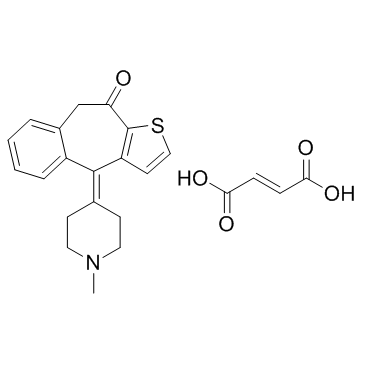34580-14-8
| Name | (E)-but-2-enedioic acid,10-(1-methylpiperidin-4-ylidene)-5H-benzo[1,2]cyclohepta[3,4-b]thiophen-4-one |
|---|---|
| Synonyms |
Ketotifen hydrogen fumarate
Zaditor 4-(1-methylpiperidin-4-ylidene)-4,9-dihydro-10H-benzo[4,5]cyclohepta[1,2-b]thiophen-10-one (2E)-but-2-enedioate acide (2E)-but-2-ènedioïque - 4-(1-méthylpipéridin-4-ylidène)-4,9-dihydro-10H-benzo[4,5]cyclohepta[1,2-b]thiophén-10-one (1:1) Ketotifen fumarate 4-(1-Methylpiperidin-4-ylidene)-4,9-dihydro-10H-benzo[4,5]cyclohepta[1,2-b]thiophen-10-one (2E)-but-2-enedioate (1:1) UNII:HBD503WORO Ketotifen fumarate salt Alaway 10H-Benzo[4,5]cyclohepta[1,2-b]thiophen-10-one, 4,9-dihydro-4-(1-methyl-4-piperidinylidene)-, (2E)-2-butenedioate (1:1) (2E)-But-2-endisäure--4-(1-methylpiperidin-4-yliden)-4,9-dihydro-10H-benzo[4,5]cyclohepta[1,2-b]thiophen-10-on(1:1) Zaditen UNII-HBD503WORO MFCD00079394 4-(1-Methyl-4-piperidinylidene)-4,9-dihydro-10H-benzo[4,5]cyclohepta[1,2-b]thiophen-10-one (2E)-2-butenedioate (1:1) EINECS 252-100-0 Ketotifen (fumarate) |
| Description | Ketotifen (fumarate) is a second-generation noncompetitive H1-antihistamine and mast cell stabilizer, which is used to prevent asthma attacks.Target: Histamine Receptor Ketotifen is a second-generation noncompetitive H1-antihistamine and mast cell stabilizer. It is most commonly sold as a salt of fumaric acid,ketotifen fumarate, and is available in two forms. In its ophthalmic form, it is used to treat allergic conjunctivitis, or the itchy red eyes caused by allergies. In its oral form, it is used to prevent asthma attacks. Side effects include drowsiness, weight gain, dry mouth, irritability, and increased nosebleeds.Ketotifen relieves and prevents eye itchiness and/or irritation associated with most seasonal allergies. It starts working within minutes after administering the drops. The drug has not been studied in children under three. The mean elimination half life is 12 hours. Besides its anti-histaminic activity, it is also a functional leukotriene antagonist and a phosphodiesterase inhibitor. The drug may also help relieve the symptoms of Irritable bowel syndrome. |
|---|---|
| Related Catalog | |
| References |
| Density | 0.968 g/mL at 25 °C(lit.) |
|---|---|
| Boiling Point | 250-263 °C(lit.) |
| Melting Point | -43°C |
| Molecular Formula | C23H23NO5S |
| Molecular Weight | 425.497 |
| Flash Point | 96-98°C/5mm |
| Exact Mass | 425.129700 |
| PSA | 123.15000 |
| LogP | 3.66410 |
| Index of Refraction | n20/D 1.522(lit.) |
| Storage condition | Store at RT |
CHEMICAL IDENTIFICATION
HEALTH HAZARD DATAACUTE TOXICITY DATA
|
| Symbol |

GHS07 |
|---|---|
| Signal Word | Warning |
| Hazard Statements | H302 |
| Precautionary Statements | P301 + P312 + P330 |
| Personal Protective Equipment | dust mask type N95 (US);Eyeshields;Faceshields;Gloves |
| Hazard Codes | Xn:Harmful |
| Risk Phrases | R22 |
| Safety Phrases | S36 |
| RIDADR | NONH for all modes of transport |
| WGK Germany | 3 |
| RTECS | DE8260000 |
| HS Code | 2934999090 |
| HS Code | 2934999090 |
|---|---|
| Summary | 2934999090. other heterocyclic compounds. VAT:17.0%. Tax rebate rate:13.0%. . MFN tariff:6.5%. General tariff:20.0% |
